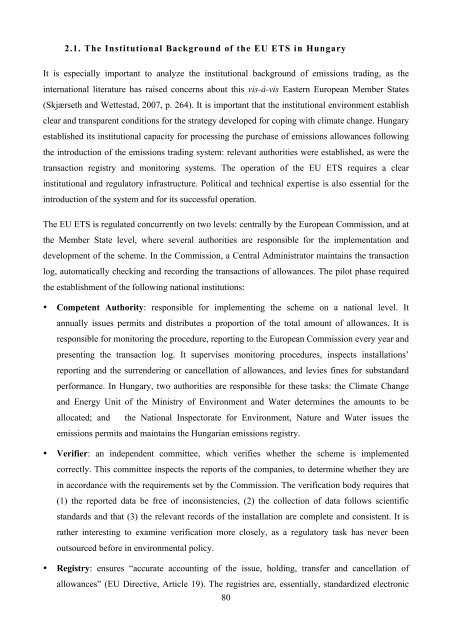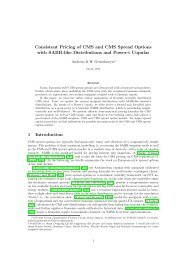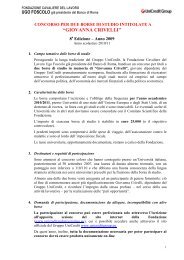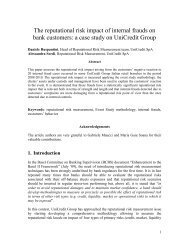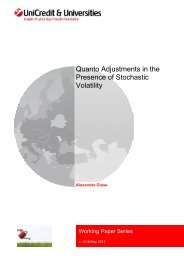Dóra Fazekas Carbon Market Implications for new EU - UniCredit ...
Dóra Fazekas Carbon Market Implications for new EU - UniCredit ...
Dóra Fazekas Carbon Market Implications for new EU - UniCredit ...
Create successful ePaper yourself
Turn your PDF publications into a flip-book with our unique Google optimized e-Paper software.
2.1. The Institutional Background of the <strong>EU</strong> ETS in Hungary<br />
It is especially important to analyze the institutional background of emissions trading, as the<br />
international literature has raised concerns about this vis-à-vis Eastern European Member States<br />
(Skjærseth and Wettestad, 2007, p. 264). It is important that the institutional environment establish<br />
clear and transparent conditions <strong>for</strong> the strategy developed <strong>for</strong> coping with climate change. Hungary<br />
established its institutional capacity <strong>for</strong> processing the purchase of emissions allowances following<br />
the introduction of the emissions trading system: relevant authorities were established, as were the<br />
transaction registry and monitoring systems. The operation of the <strong>EU</strong> ETS requires a clear<br />
institutional and regulatory infrastructure. Political and technical expertise is also essential <strong>for</strong> the<br />
introduction of the system and <strong>for</strong> its successful operation.<br />
The <strong>EU</strong> ETS is regulated concurrently on two levels: centrally by the European Commission, and at<br />
the Member State level, where several authorities are responsible <strong>for</strong> the implementation and<br />
development of the scheme. In the Commission, a Central Administrator maintains the transaction<br />
log, automatically checking and recording the transactions of allowances. The pilot phase required<br />
the establishment of the following national institutions:<br />
• Competent Authority: responsible <strong>for</strong> implementing the scheme on a national level. It<br />
annually issues permits and distributes a proportion of the total amount of allowances. It is<br />
responsible <strong>for</strong> monitoring the procedure, reporting to the European Commission every year and<br />
presenting the transaction log. It supervises monitoring procedures, inspects installations’<br />
reporting and the surrendering or cancellation of allowances, and levies fines <strong>for</strong> substandard<br />
per<strong>for</strong>mance. In Hungary, two authorities are responsible <strong>for</strong> these tasks: the Climate Change<br />
and Energy Unit of the Ministry of Environment and Water determines the amounts to be<br />
allocated; and the National Inspectorate <strong>for</strong> Environment, Nature and Water issues the<br />
emissions permits and maintains the Hungarian emissions registry.<br />
• Verifier: an independent committee, which verifies whether the scheme is implemented<br />
correctly. This committee inspects the reports of the companies, to determine whether they are<br />
in accordance with the requirements set by the Commission. The verification body requires that<br />
(1) the reported data be free of inconsistencies, (2) the collection of data follows scientific<br />
standards and that (3) the relevant records of the installation are complete and consistent. It is<br />
rather interesting to examine verification more closely, as a regulatory task has never been<br />
outsourced be<strong>for</strong>e in environmental policy.<br />
• Registry: ensures “accurate accounting of the issue, holding, transfer and cancellation of<br />
allowances” (<strong>EU</strong> Directive, Article 19). The registries are, essentially, standardized electronic<br />
80


